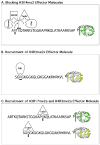Histone arginine methylation
- PMID: 21074527
- PMCID: PMC3409563
- DOI: 10.1016/j.febslet.2010.11.010
Histone arginine methylation
Abstract
Arginine methylation is a common posttranslational modification (PTM). This type of PTM occurs on both nuclear and cytoplasmic proteins, and is particularly abundant on shuttling proteins. In this review, we will focus on one aspect of this PTM: the diverse roles that arginine methylation of the core histone tails play in regulating chromatin function. A family of nine protein arginine methyltransferases (PRMTs) catalyze methylation reactions, and a subset target histones. Importantly, arginine methylation of histone tails can promote or prevent the docking of key transcriptional effector molecules, thus playing a central role in the orchestration of the histone code.
Copyright © 2010 Federation of European Biochemical Societies. Published by Elsevier B.V. All rights reserved.
Figures


References
-
- Katz JE, Dlakic M, Clarke S. Automated identification of putative methyltransferases from genomic open reading frames. Mol Cell Proteomics. 2003;2:525–40. - PubMed
-
- Lin WJ, Gary JD, Yang MC, Clarke S, Herschman HR. The mammalian immediate-early TIS21 protein and the leukemia-associated BTG1 protein interact with a protein-arginine N-methyltransferase. J Biol Chem. 1996;271:15034–44. - PubMed
-
- Tang J, Frankel A, Cook RJ, Kim S, Paik WK, Williams KR, Clarke S, Herschman HR. PRMT1 is the predominant type I protein arginine methyltransferase in mammalian cells. J Biol Chem. 2000;275:7723–30. - PubMed
Publication types
MeSH terms
Substances
Grants and funding
LinkOut - more resources
Full Text Sources
Other Literature Sources

